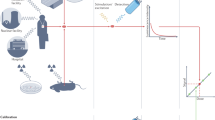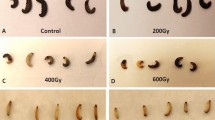Abstract
THE photodynamic effect of cancerogenic substances was examined by Mottram and Doniach1 using Paramecium. They found that the cancerogenic substances had a stronger effect than the non-cancerogenic photosensitizers. We have tried to estimate the photodynamic effect of cancerogenic substances by means of a standard biological indicator, namely, the 3rd stage larvæ of Drosophila melanogaster, as it is known that they are suitable for the standardizing and measuring of radiation.
This is a preview of subscription content, access via your institution
Access options
Subscribe to this journal
Receive 51 print issues and online access
$199.00 per year
only $3.90 per issue
Buy this article
- Purchase on Springer Link
- Instant access to full article PDF
Prices may be subject to local taxes which are calculated during checkout
Similar content being viewed by others
References
Mottram and Doniach, Nature, 140, 933 (1937).
Author information
Authors and Affiliations
Rights and permissions
About this article
Cite this article
MATOLTSY, G., FÁBIÁN, G. Measurement of the Photodynamic Effect of Cancerogenic Substances with Biological Indicators. Nature 158, 877–878 (1946). https://doi.org/10.1038/158877b0
Issue Date:
DOI: https://doi.org/10.1038/158877b0
This article is cited by
-
Part IV: Basic Considerations of the Psoralens: The Mechanism of the Photodynamic Effect121From the Division of Dermatology, University of Oregon Medical School, Portland, Oregon.2This work was supported by funds from the United States Public Health Service grant number C 2837 (PET).
Journal of Investigative Dermatology (1959)
Comments
By submitting a comment you agree to abide by our Terms and Community Guidelines. If you find something abusive or that does not comply with our terms or guidelines please flag it as inappropriate.



